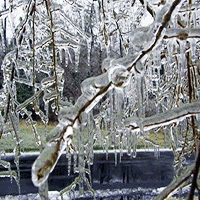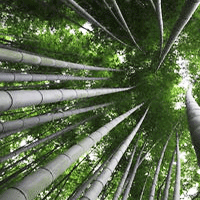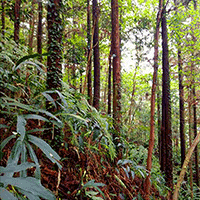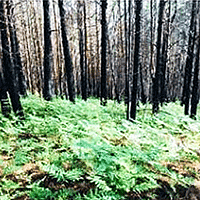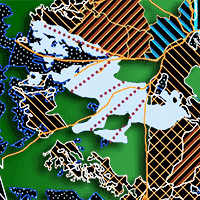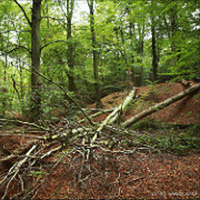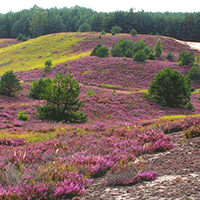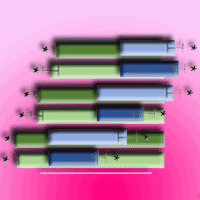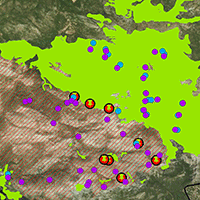Ice storm is a major form of extreme climatic event and may occur more frequently in the future under a changing climate. The 2008 Chinese ice storm provided a natural laboratory to study ecosystem responses and feedbacks to climate variability and extreme events. Four typical subtropical forests (Chinese fir plantation, pine plantation, moso bamboo plantation, and secondary mixed broadleaved forest) were selected to assess the damage caused by the ice storm. The ice damage rate of typical subtropical forests varied between 25% and 81%. The secondary broadleaved forest had most extensive damage while the Chinese fir plantation experienced the most severe damage. Exotic pine species (Pinus elliottii Engelm. and Pinus taeda Linn.) were more severely damaged than the native species, Pinus massoniana Lamb. Ice damage was also affected by tree/culm size, age, stand density, site altitude, and management practices. Large-sized trees/culms were more vulnerable to stem breakage, decapitation, and uprooting, while small-sized trees/culms were more vulnerable to bending and leaning. Younger trees/culms had the highest damage rate, and were more susceptible to bending damage. Ice damage rate increased linearly with the stand density, and higher altitude led to a significant increase of stem breakage. Oleoresin tapping aggravated the damage to pine trees. Resistance of trees to ice damage is an emergent consequence of tree attributes, species origin, site conditions, and human disturbance. Forest silviculture and management practices can play significant roles in controlling forest susceptibility to extreme events. Inappropriate utilization of non-timber forest products can reduce trees’ resistance to extreme events. For sustainable forest development, balance needs to be achieved between the high productivity of introduced exotic tree species and the resistance of native species to extreme climatic events.
Keywords
, , , , ,
Citation
Zhou B, Wang X, Cao Y, Ge X, Gu L, Meng J (2017). Damage assessment to subtropical forests following the 2008 Chinese ice storm. iForest 10: 406-415. - doi: 10.3832/ifor1619-009
Academic Editor
Paola Mairota
Paper history
Received: Feb 25, 2015
Accepted: Dec 08, 2016
First online: Mar 24, 2017
Publication Date: Apr 30, 2017
Publication Time: 3.53 months
© SISEF - The Italian Society of Silviculture and Forest Ecology 2017
Open Access
This article is distributed under the terms of the Creative Commons Attribution-Non Commercial 4.0 International (https://creativecommons.org/licenses/by-nc/4.0/), which permits unrestricted use, distribution, and reproduction in any medium, provided you give appropriate credit to the original author(s) and the source, provide a link to the Creative Commons license, and indicate if changes were made.

Breakdown by View Type
(Waiting for server response...)
Article Usage
Total Article Views: 50709
(from publication date up to now)
Breakdown by View Type
HTML Page Views: 42079
Abstract Page Views: 3836
PDF Downloads: 3577
Citation/Reference Downloads: 21
XML Downloads: 1196
Web Metrics
Days since publication: 3211
Overall contacts: 50709
Avg. contacts per week: 110.55
Article Citations
Article citations are based on data periodically collected from the Clarivate Web of Science web site
(last update: Mar 2025)
Total number of cites (since 2017): 16
Average cites per year: 1.78
Publication Metrics
by Dimensions ©
Articles citing this article
List of the papers citing this article based on CrossRef Cited-by.
(1)
Abell CA (1934)Influence of glaze storm upon hardwood forests in the southern Appalachians. Journal of Forestry 32: 35-37.
Gscholar
(2)
Amateis RL, Burkhart HE (1996)Impact of heavy glaze in a loblolly pine spacing trial. Southern Journal of Applied Forestry 20: 151-155.
Online |
Gscholar
(3)
Belanger R, Godbee J, Anderson R, Paul J (1996)Ice damage in thinned and nonthinned loblolly pine plantations infected with fusiform rust. Southern Journal of Applied Forestry 20: 136-142.
Online |
Gscholar
(4)
Bragg DC, Shelton MG, Zeide B (2003)Impacts and management implications of ice storms on forests in the southern United States. Forest Ecology and Management 186: 99-123.
CrossRef |
Gscholar
(5)
Bragg DC, Shelton MG (2010)Recovery of planted loblolly pine 5 years after severe ice storms in Arkansas. Southern Journal of Applied Forestry 34 (1): 13-20.
Online |
Gscholar
(6)
Bruederle LP, Stearns FW (1985)Ice storm damage to a southern Wisconsin mesic forest. Bulletin of the Torrey Botanical Club 167-175.
Online |
Gscholar
(7)
Cremer K, Borough C, McKinnell F, Carter P (1982)Effects of stocking and thinning on wind damage in pine plantations. New Zealand Journal of Forestry Science 12: 244-268. -
Online |
Gscholar
(8)
Cooper-Ellis S, Foster DR, Carlton G, Lezberg A (1999)Forest response to catastrophic wind: results from an experimental hurricane. Ecology 80: 2683-2696.
CrossRef |
Gscholar
(9)
FAO (2009)State of the world’s forests. Food and Agriculture Organization of the United Nations, Rome, Italy, pp. 147.
Gscholar
(10)
Guo ZW, Zeng GL, Peng ZL, Zheng XC, Liu DC (2012)Study on resin tapping technology of
Pinus elliottii with cortical horizontal streaks. Jiangxi Journal of Forestry Science and Technology 2: 2-7.
Online |
Gscholar
(11)
Harrington CA, DeBell DS (1996)Above- and below-ground characteristics associated with wind toppling in a young
Populus plantation. Trees 11: 109-118.
CrossRef |
Gscholar
(12)
Hauer RJ, Wang W, Dawson JO (1993)Ice storm damage to urban trees. Journal of Arboriculture 19: 187-193.
Online |
Gscholar
(13)
He Q, Li J-Y, Chen X-Y, Chen H-Y, Peng H-G, Fan S-J (2010)Types and extent of damage to
Cunninghamia lanceolata plantations due to unusually heavy snow and ice in southern China. Chinese Journal of Plant Ecology 34: 195-203.
CrossRef |
Gscholar
(14)
Hodges AW, Johnson JD (1997)Borehole oleoresin production from slash pine. Southern Journal of Applied Forestry 21: 108-115.
Online |
Gscholar
(15)
Huang Z, Xu Z, Boyd S, Williams D (2005)Chemical composition of decomposing stumps in successive rotation of chinese fir (
Cunninghamia lanceolata (Lamb.) Hook.) plantations. Chinese Science Bulletin 50: 2581-2586.
CrossRef |
Gscholar
(16)
IPCC (2007)Climate change 2007: the physical science basis. Contribution of Working Group I to the Fourth Assessment Report of the Intergovernmental Panel on Climate Change (Solomon S, Qin D, Manning M, Chen Z, Marquis M, Averyt KB, Tignor M, Miller HL eds). Cambridge University Press, New York, USA, pp. 996.
Gscholar
(17)
Irland LC (2000)Ice storms and forest impacts. Science of The Total Environment 262: 231-242.
CrossRef |
Gscholar
(18)
Ishii R, Higashi M (1997)Tree coexistence on a slope: an adaptive significance of trunk inclination. Proceedings of the Royal Society of London. Series B 264: 133-140.
CrossRef |
Gscholar
(19)
Klima K, Morgan MG (2015)Ice storm frequencies in a warmer climate. Climatic Change 133: 1-14.
CrossRef |
Gscholar
(20)
Lemon PC (1961)Forest ecology of ice storms. Bulletin of the Torrey Botanical Club 88: 21-29.
CrossRef |
Gscholar
(21)
Lindenmayer D, Foster D, Franklin J, Hunter M, Noss R, Schmiegelow F, Perry D (2004)Salvage harvesting policies after natural disturbance. Science 303: 1303.
CrossRef |
Gscholar
(22)
Man X, Mi X, Ma K (2011)Effects of an ice storm on community structure of an evergreen broad-leaved forest in Gutianshan National Nature Reserve, Zhejiang Province. Biodiversity Science 19: 197-205.
CrossRef |
Gscholar
(23)
Meehl GA, Karl T, Easterling DR, Changnon S, Pielke Jr R, Changnon D, Evans J, Groisman PY, Knutson TR, Kunkel KE, Mearns LO, Parmesan C (2000)An introduction to trends in extreme weather and climate events: observations, socioeconomic impacts, terrestrial ecological impacts, and model projections. Bulletin of the American Meteorological Society 81: 413-416.
CrossRef |
Gscholar
(24)
Millward AA, Kraft CE (2004)Physical influences of landscape on a large-extent ecological disturbance: the northeastern North American ice storm of 1998. Landscape Ecology 19: 99-111.
CrossRef |
Gscholar
(25)
Morris JL, Ostrofsky WD (2005)Influence of stand thinning on ice storm injury in Maine hardwood stands. Northern Journal of Applied Forestry 22 (4): 262-267.
Online |
Gscholar
(26)
Nadrowski K, Pietsch K, Baruffol M, Both S, Gutknecht J, Bruelheide H, Heklau H, Kahl A, Kahl T, Niklaus P, Krober W, Liu X, Mi X, Michalski SG, Von Oheimb G, Purschke O, Schmid B, Fang T, Welk E, Wirth C (2014)Tree species traits but not diversity mitigate stem breakage in a subtropical forest following a rare and extreme ice storm. PLoS One 9: e96022.
CrossRef |
Gscholar
(27)
Nielsen C, Van Dyke O, Pedlar J (2003)Effects of past management on ice storm damage in hardwood stands in eastern Ontario. The Forestry Chronicle 79: 70-74.
CrossRef |
Gscholar
(28)
Päätalo M-L, Peltola H, Kellomäki S (1999)Modelling the risk of snow damage to forests under short-term snow loading. Forest Ecology and Management 116: 51-70.
CrossRef |
Gscholar
(29)
Platt WJ, Doren RF, Armentano TV (2000)Effects of hurricane Andrew on stands of slash pine (
Pinus elliottii var.
Densa) in the everglades region of south Florida (USA). Plant Ecology 146: 43-60.
CrossRef |
Gscholar
(30)
Rhoads AG, Hamburg SP, Fahey TJ, Siccama TG, Hane EN, Battles J, Cogbill C, Randall J, Wilson G (2002)Effects of an intense ice storm on the structure of a northern hardwood forest. Canadian Journal of Forest Research 32: 1763-1775.
CrossRef |
Gscholar
(31)
Rustadlindsey E, Campbelljohn L (2012)A novel ice storm manipulation experiment in a northern hardwood forest. Canadian Journal of Forest Research 42: 1810-1818.
CrossRef |
Gscholar
(32)
Ryall K, Smith S (2005)Patterns of damage and mortality in red pine plantations following a major ice storm. Canadian Journal of Forest Research 35: 487-493.
CrossRef |
Gscholar
(33)
Schütz J-P, Götz M, Schmid W (2006)Vulnerability of spruce (
Picea abies) and beech (
Fagus sylvatica) forest stands to storms and consequences for silviculture. European Journal of Forest Research 125 (3): 291-302.
CrossRef |
Gscholar
(34)
Shao Q, Huang L, Liu J, Kuang W, Li J (2011)Analysis of forest damage caused by the snow and ice chaos along a transect across southern China in spring 2008. Journal of Geographical Sciences 21: 219-234.
CrossRef |
Gscholar
(35)
Sterck F, Bongers F (1998)Ontogenetic changes in size, allometry, and mechanical design of tropical rain forest trees. American Journal of Botany 85: 266-272.
CrossRef |
Gscholar
(36)
Stokstad E (2006)Salvage logging research continues to generate sparks. Science 311: 761-761.
CrossRef |
Gscholar
(37)
Stone R (2008)Ecologists report huge storm losses in China’s forests. Science 319: 1318-1319.
CrossRef |
Gscholar
(38)
Su Z-Y, Liu G, Ou Y-D, Dai Z-H, Li Z-K (2010)Storm damage in a montane evergreen broadleaved forest of Chebaling National Nature Reserve, South China. Chinese Journal of Plant Ecology 34: 213-222.
CrossRef |
Gscholar
(39)
Valinger E, Lundqvist L (1992)The influence of thinning and nitrogen fertilization on the frequency of snow and wind induced stand damage in forests. Scottish Forestry 46: 311-320.
Gscholar
(40)
Wang X, Huang S, Zhou G, Li J, Qiu Z, Zhao X, Zou B (2009)Effects of the frozen rain and snow disaster on the dominant species of
Castanopsis forest in Yangdongshan Shierdushui Provincial Nature Reserve of Guangdong. Scientia Silvae Sinicae 45: 42-47.
Gscholar
(41)
Wang B, Wei W, Liu C, You W, Niu X, Man R (2013)Biomass and carbon stock in moso bamboo forests in subtropical china: Characteristics and implications. Journal of Tropical Forest Science 25: 137-148.
Online |
Gscholar
(42)
Whitney HE, Johnson WC (1984)Ice storms and forest succession in southwestern Virginia. Bulletin of the Torrey Botanical Club 111: 429-437.
CrossRef |
Gscholar
(43)
Xi CP (1993)Soil classification system of China. China Agric. Publ. House, Beijing, China, pp. 75-85.
Gscholar
(44)
Xu J, Li G, Lu Z, Xiang D, Zeng B, Zhang N (2008)Investigation on Eucalypt forest plantations subjected to the freezing catastrophe in southern China. Scientia Silvae Sinicae 44: 103-110.
Online |
Gscholar
(45)
Yorks TE, Adams KB (2005)Ice storm impact and management implications for jack pine and pitch pine stands in New York, USA. The Forestry Chronicle 81: 502-515.
CrossRef |
Gscholar
(46)
Zhou B, Cao Y, Wang X, Ge X (2013)Ecological impact assessment on the China’s ice storm in 2008. Advanced Materials Research 726: 992-996.
CrossRef |
Gscholar
(47)
Zhou B, Fu M, Xie J, Li Z (2005)Ecological functions of bamboo forest: Research and application, Journal of Forestry Research 16: 143-147.
CrossRef |
Gscholar
(48)
Zhou B, Gu L, Ding Y, Shao L, Wu Z, Yang X, Li C, Li Z, Wang X, Cao Y, Zeng B (2011a)The great 2008 Chinese ice storm: its socioeconomic-ecological impact and sustainability lessons learned. Bulletin of the American Meteorological Society 92: 47-60.
CrossRef |
Gscholar
(49)
Zhou B, Li Z, Wang X, Cao Y, An Y, Deng Z, Letu G, Wang G, Gu L (2011b)Impact of the 2008 ice storm on moso bamboo plantations in southeast china. Journal of Geophysical Research: Biogeosciences 116: G00H06.
CrossRef |
Gscholar
(50)
Zhou B, Yu M, Cao Y, Wang X, Sun H, Ai C, Gu L (2011c)Impact of the 2008 ice storm on China’s forests. In: Proceedings of the “International Symposium on Water Resource and Environmental Protection (ISWREP)”. Xi’an (China) 20-22 May 2011. IEEE Xplore, pp. 2652-2656.
CrossRef |
Gscholar
(51)
Zhu J, Li X, Liu Z, Cao W, Gonda Y, Matsuzaki T (2006)Factors affecting the snow and wind induced damage of a montane secondary forest in northeastern china. Silva Fennica 40: 37-51.
CrossRef |
Gscholar
